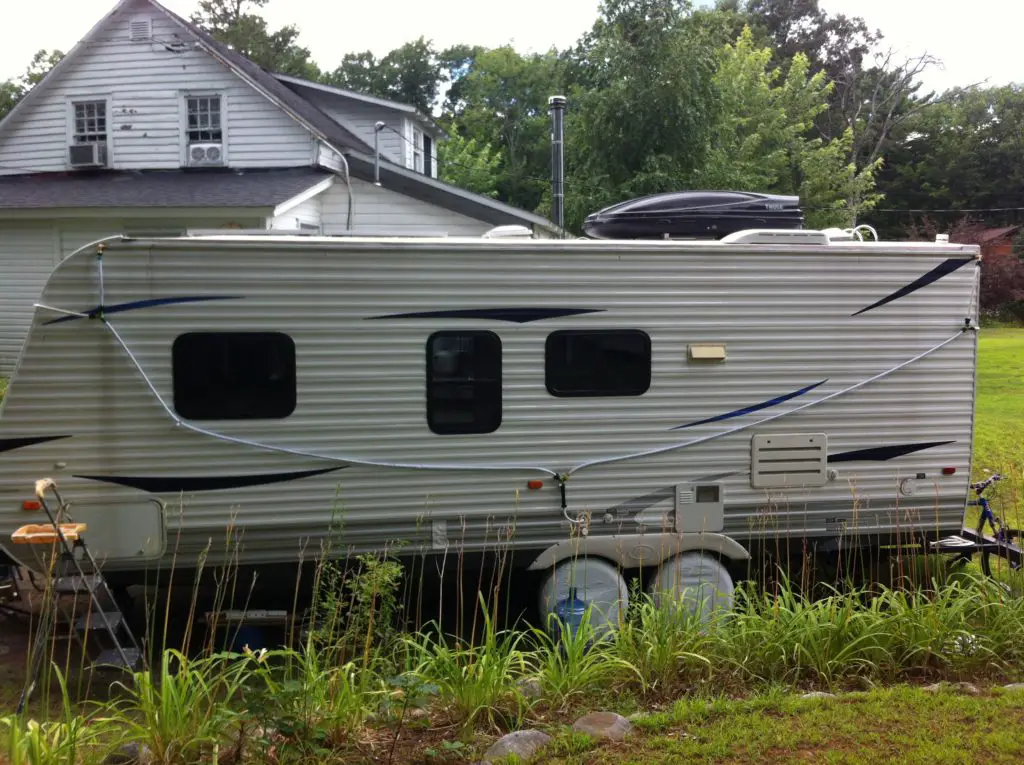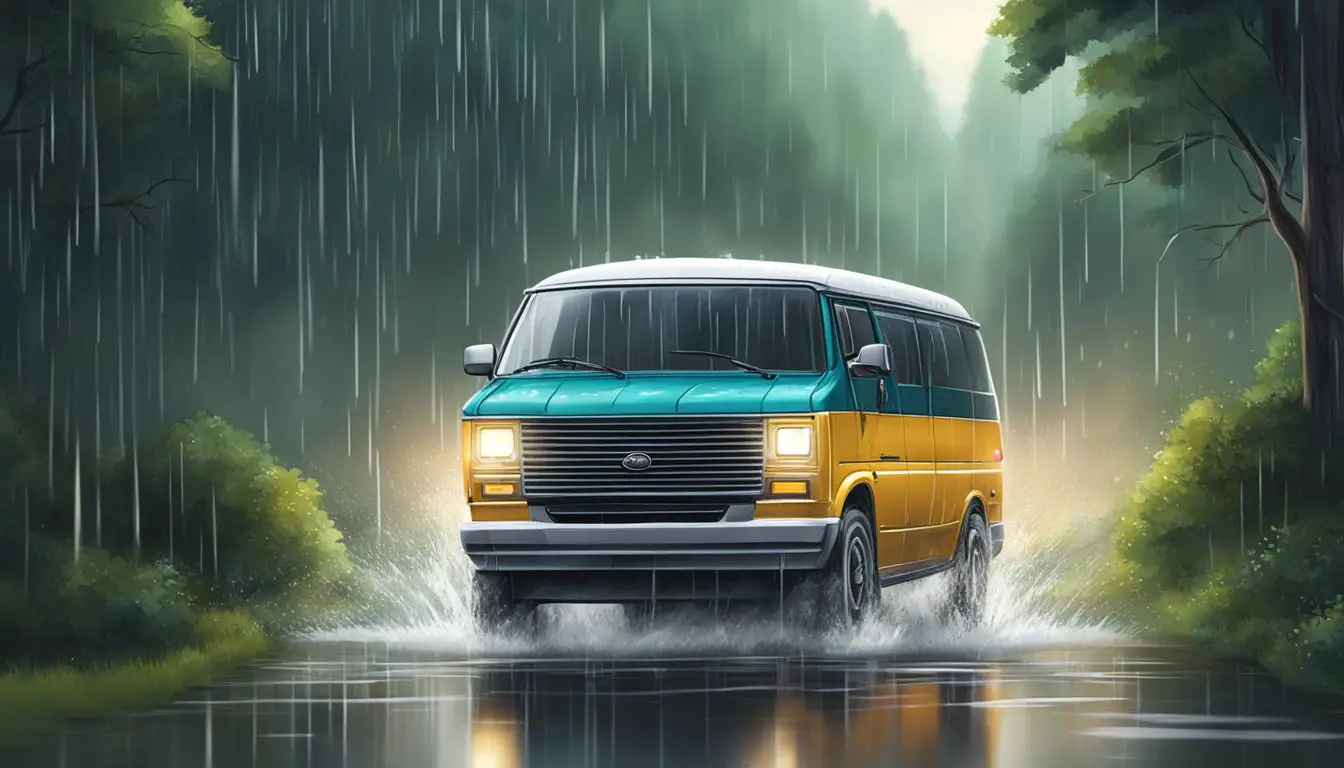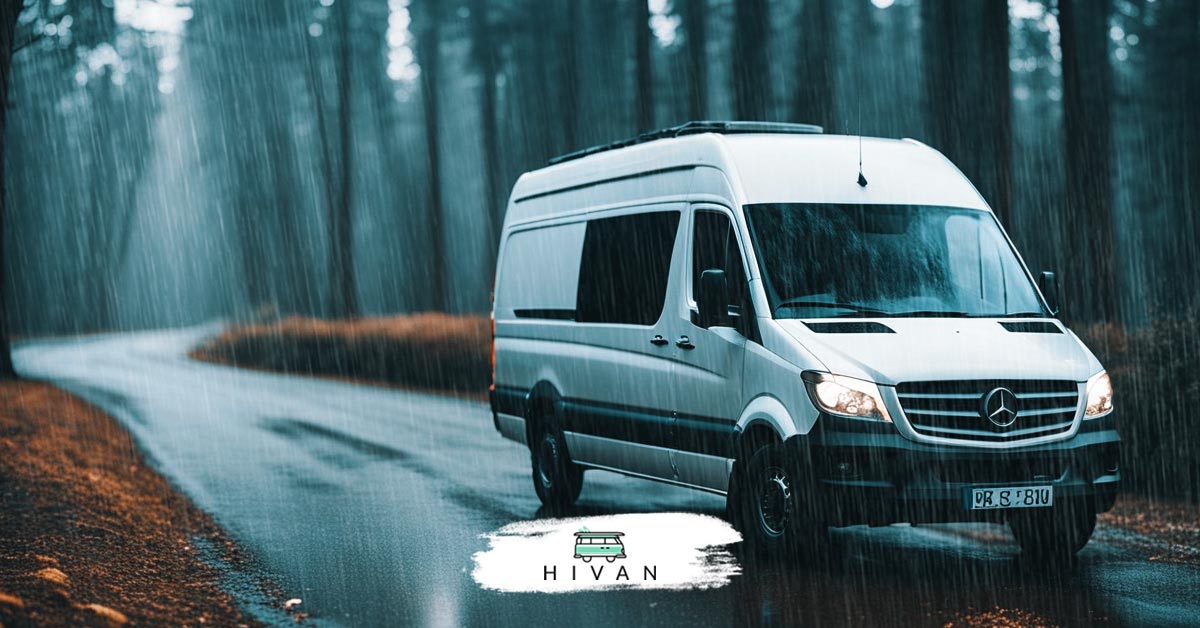You never know when you’re going to find an awesome site where you’ll want to wild camp for a week or more. And that means having or being able to forage enough supplies to see you through. The ability to capture rainwater helps you to be fully self-sustained, no matter your van’s location.
Start by assessing your water needs and the collection system that’ll suit your lifestyle. Pick the right rain harvesting equipment for your van and put systems in place that guarantee a clean water supply.

In this Van Life Complete Guide to rainwater collection, we’ll walk through the following steps:
- The basic principles of rainwater collection
- Identifying your requirements, so you put in the best system
- The equipment you’ll need for effective rain harvesting
- How to set up a straightforward water collecting system
- Tips for making your rainwater harvest safe to drink
Understand the Basic Principles of Rainwater Collection

Ever since humans worked out how to contain water, they’ve been collecting rainwater and storing it for use. Once it was in ceramic pots, and for today’s Van Lifers, rainwater collection is stored in plastic tanks.
The main steps to create a Van Life Rainwater Collection system consist of the following:
- Determine the best location for your water storage tank and ensure that it is secure.
- Install a gutter system on the roof of your van to collect rainwater and direct it into the storage tank.
- Install a filter to remove debris and other contaminants from the collected rainwater.
- Install a pump to move the collected rainwater from the storage tank to your sink or shower.
- Install a water level gauge to monitor the amount of water in your storage tank.
- Ensure that your system is properly maintained and cleaned regularly to prevent contamination.
While the principles are simple, they’re there to protect the quality of water you gather. Before we look at the components you’ll need for rainwater collection; it’s time to figure out your rainwater needs.
Identify Your Requirements for a Rainwater Collection System

Before you start on your collection system, think about the following:
- How do you plan to use the water? If you’re going to drink the rainwater, you’ll need to install a water treatment system to remove any contaminants like waterborne viruses or parasites.
- What size and type of water storage system do you have? With rainwater runoff connected directly to your water storage tank, you’ll need to think about installing a shut-off or overflow system. Alternatively, have separate collection barrels then siphon the water to your storage units.
- What’s your budget? Rainwater collection can suit the budget-conscious, or it can be costly, especially when you factor in water treatment systems. We’ll look at affordable methods to collect clean rainwater shortly.
- How much work are you prepared to put in? A rainwater collection system can be put together quickly and simply. However, some Van Lifers install a permanent system that requires running pipes from the collection point then passing into the van. Inside the van, the pipes connect to the water storage tank.
Some rainwater collection systems are more time-consuming and costly to set-up than others. For the sake of simplicity, time-effectiveness, and budget, we’re going to look at setting up a rain-catching technique that goes from the gutter to the water storage tank via an inline filter system.
Invest in the Right Equipment
No matter what your van is, you might opt for the straightforward gutter to barrel rainwater collection system. Alternatively, you may decide to install a rainwater run-off tube through a filtration system direct to your van’s water storage tank. One option is less labor intensive than the other. This guide looks at the simpler set-up.
Here’s what you’ll need to prepare your rainwater collection system:
- Gutters. Your RV or van may already have gunnels to direct water flow off your van. If not, the first step is to get yourself some RV guttering. Attach the gutters to the top edge of the van to gather rain coming off the roof.
- Gutter run-off. A run-off hooks onto the gutter. It extends beyond the edge of the van and acts as a funnel. Look for a product like Camco’s RV Gutter Spout.
Useful tip: Make sure your water collection system’s entry point has a mesh filter system to remove any debris like leaves.
- Water collection storage tanks. These should be sealable to keep out bugs and to prevent spills. Place a mesh filter across the top of the collection tanks to filter the water as the water goes in.
- 12-volt water pump. If you plan on transferring water through to your van’s water storage unit, you’ll need a 12-volt pump to transfer the water through piping.
You’ll notice I haven’t included rainwater filtration on this list. That’s because there are a couple of options to choose from. We’ll take a look at how to treat your rainwater later.
Putting Your Rainwater Collection System Together
Let’s walk through the steps of collecting rainwater:
- Install guttering. Fix your RV gutter along the top sides of your van and even across the top of your windscreen. The more guttering you have, the bigger the collection area. Use a waterproof RV sealant to set the gutters in place.
- Affix gutter run-offs to the guttering. Gutter run-offs shoot water clear of the sides of the van. It’s this trajectory of water that you’ll be catching with your collection tanks.
- Tip to keep debris out of your water. Place a thin mesh system across the run-off or look for a system that has an inbuilt filter. This will catch any twigs, leaves, or bugs and prevent them from getting into your water.
- Place clean, plastic water collection tanks underneath the run-off spouts. With an open-topped collection tank, the water will run or trickle from the run-offs and drop into the clean tanks. Be careful to ensure there’s no splash-back. That is, if you’re in a muddy or dusty setting, be sure that contaminated dirty water droplets can’t enter.
- Pump the water from the collection tanks to your water storage tank. Chances are you’re collecting rainwater in units that you’ll store straight into your van. However, it’s beneficial to filter your harvested water. Use your 12-volt water pump to channel water directly from the collection points via a filter, like the Camco TastePURE Inline RV water filter, to your van’s water tank.
You needn’t even follow step 4 if you plan on capturing the water in water storage units. However, by equipping yourself with a 12-volt water pump, you also gain the opportunity to draw water from other water reserves too.
To return to the principles of rainwater collection, ensure the cleanliness of your gathering and collection points. Use filters and meshes where you can to limit contaminants. It’s also highly recommended that you clean the van gutters regularly.
Here’s a great video from the Youtube channel “Our Self-Reliant Life” which explains you the basic principles of a rainwater collection system:
How to Make Your Rainwater Collection Safe Enough to Drink
According to the CDC, it is possible that rainwater may contain viruses or parasites. If you’re thinking about drinking the rainwater you harvest, you’ll need to think about treating the water, too.
Michael Smith, the founder of Truck Camper Adventure, offers two solutions to water filtering. The first recommendation is to use an in-line RV water filter, such as the Camco TastePURE Inline RV water filter. Attach this to the hose you use to pump your water from your collection point through to your van’s water storage tank for cleaner, safer drinking water.
The second option is a solid investment in clean water, and that’s the Doulton Stainless Steel Gravity Filter System. This portable filter removes all kinds of organic and chemical contaminants, so if you’re concerned about the safety of drinking rainwater, this will give you peace of mind.
Final Thoughts
Rainwater collection is a great means of ensuring you remain self-sustaining, adventuring, and hydrated. You now have all the information you need to assess the kind of system you need and the fundamental components to carry so that your van life rainwater collection is a hassle-free process.
